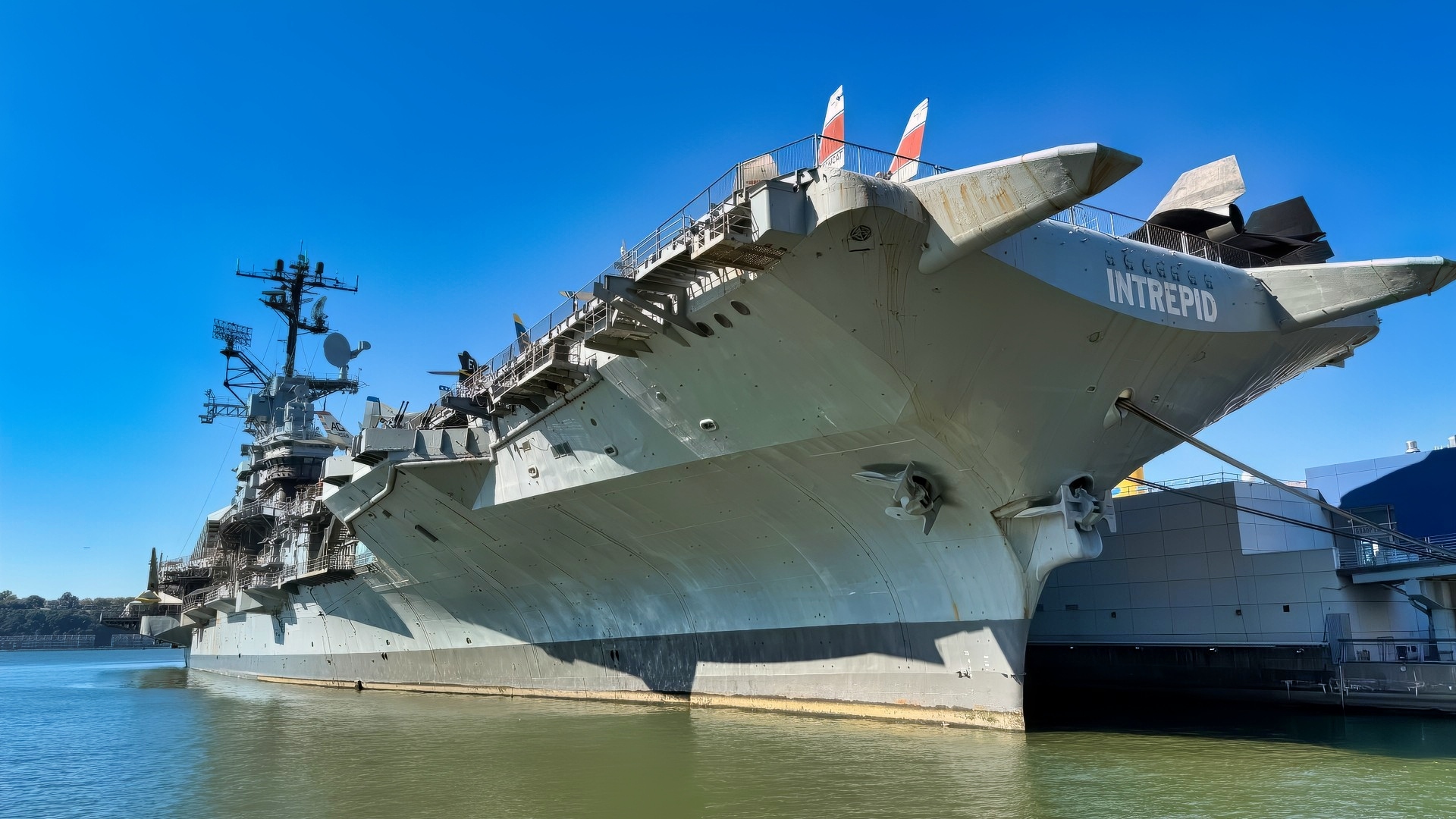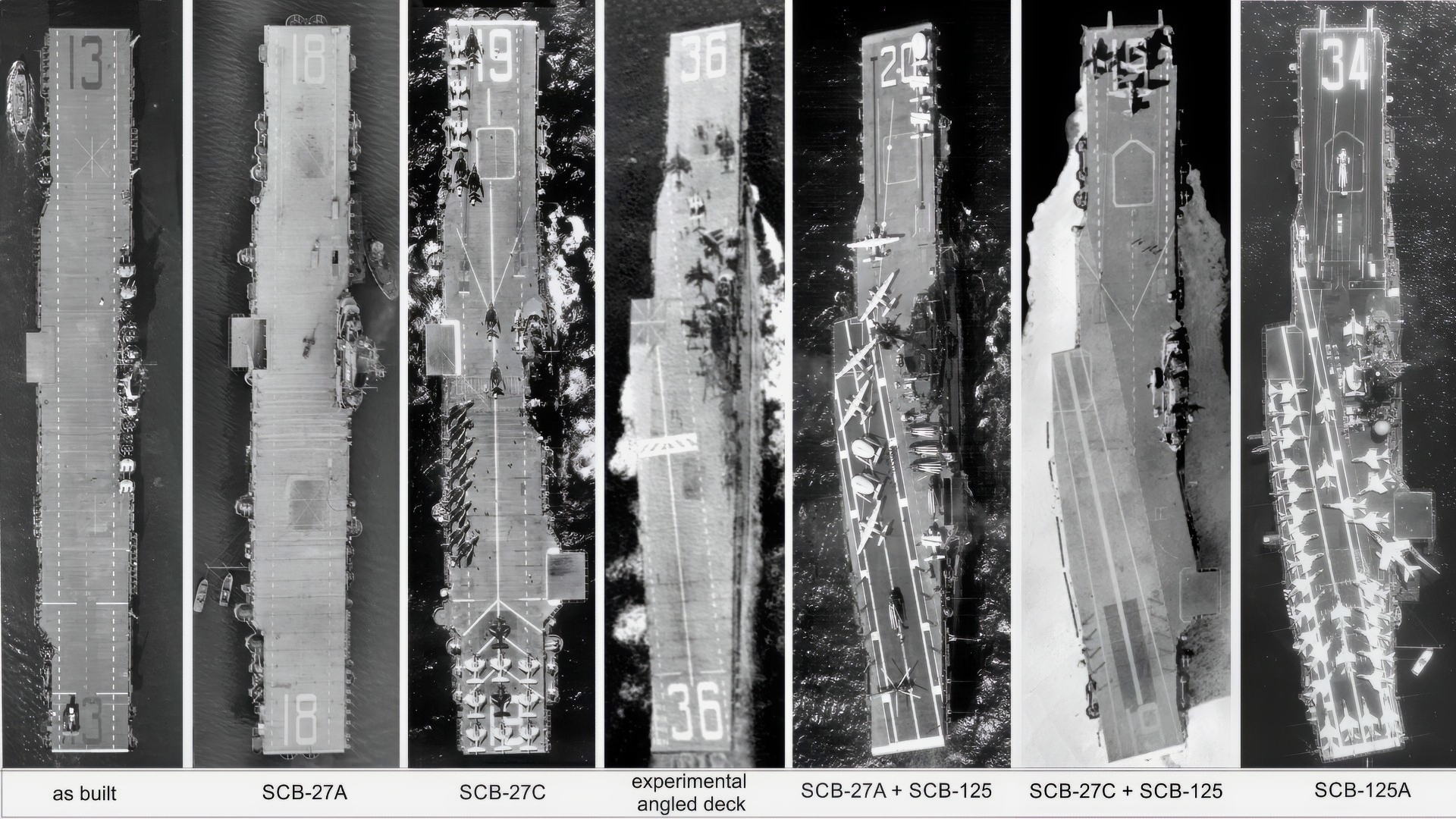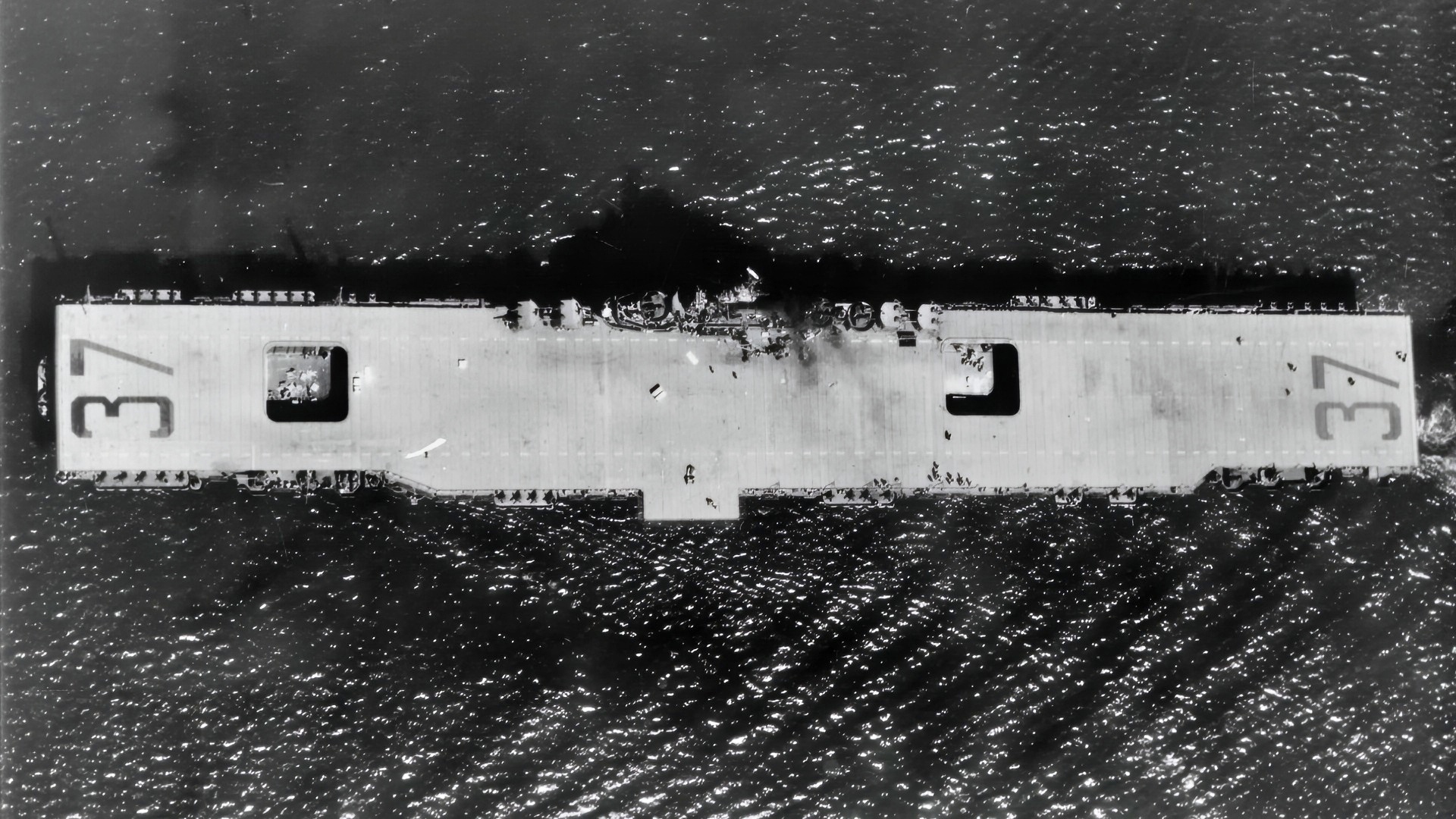Key Points and Summary – Launched too late for WWII, the Essex-class USS Princeton (CV-37) quickly earned distinction in Korea, flying hundreds of strike sorties—from wrecking bridges and power sites to the famed VA-195 “Dambusters” torpedo attack on a dam.
-A dramatic 1951 incident saw a blinded F9F pilot coached to a safe deck landing by his wingman.

USS Intrepid Essex-Class Aircraft Carrier National Security Journal Original Image. Taken by Jack Buckby on 9/18/2025.
-After multiple Korean deployments, Princeton shifted to ASW duties, then converted to amphibious assault carrier LPH-5, supporting Vietnam operations like Deckhouse I.
-She also hosted the film Flat Top and, in 1969, served as prime recovery ship for Apollo 10. Decommissioned in 1970, Princeton earned 14 battle stars.
-We have included several additional Essex-class photos to give you an idea of what this class of carrier looked like.
Meet USS Princeton
The USS Princeton (CV-37) was laid down at the Philadelphia Navy Yard as an Essex-class aircraft carrier. It launched on July 8, 1945, which was too late for service in World War II.
According to Naval History and Heritage Command, the Princeton spent its first year or so in the Atlantic before it was transferred to the Pacific fleet. Then, in 1946, it transferred the body of Manuel L. Quezon, the president of the Philippines, back home for burial.
The ship was decommissioned for a time in 1948, becoming part of the Pacific Reserve Fleet. With the start of the Korean War, the Princeton was reactivated in August 1950.
The Princeton in Korea
The ship “launched 248 sorties against targets in the Hagaru area to announce her arrival, and for the next six days continued the pace to support marines fighting their way down the long, cold road from the Chosin Reservoir to Hungnam.”

The Mighty Essex-Class Aircraft Carrier. Image Credit: Creative Commons.
Planes launched from the Princeton continued to batter North Korea throughout the war.
“By 4 April Princeton’s planes had rendered 54 rail and 37 highway bridges inoperable and damaged 44 more,” according to Naval History and Heritage Command. Later, raids were conducted against power sources. “For much of the summer, they pounded supply arteries, concentrating on highways.”
The Aviation Geek Club wrote last year about the time in the spring of 1951 that the VA-195 Skyraiders, known as the “US Navy Dambusters,” struck a dam with aerial torpedoes. Those torpedoes were launched by the USS Princeton’s VA-195 and VC-35:
“Striking in pairs, the Skyraiders ran the gauntlet down the valley, with Lt Cdr Carlson in the lead. Despite AAA batteries desperately trying to shoot them down, the attack pilots managed to hole the dam with their bombs. The ‘Tiny Tim’ rockets were ineffective, however, and no sluice gates were damaged,” The Aviation Geek Club recalled .
Also in 1951, as related this March by Vintage Aviation News, “a true aviation miracle took place.”
A pair of United States Navy F9F Panther fighter jets from Fighter Squadron VF-191, known as “Satan’s Kittens,” were on a ground attack mission. One of the pilots, Ensign Floryan “Frank” Sobieski, was struck by ground fire. Neither he nor the plane was harmed, but the ensign found himself temporarily blinded.
His wingman, Lieutenant junior grade Pat Murphy, stayed on his tail, and thanks to Murphy’s guidance, Sobieski was able to land his plane on the deck of the Princeton. He recovered his vision soon after.
“This remarkable story lives on as a testament to true camaraderie and the unbreakable bond between fellow aviators—showing what it truly means to have each other’s backs,” Vintage Aviation News reported of the episode.
Crossing the Pacific
That August, the ship headed back to San Diego before returning to the war zone in Korea in April of 1952. For the next 138 days, “her planes flew against the enemy.”
“They sank small craft to prevent the recapture of offshore islands; blasted concentrations of supplies, facilities, and equipment behind enemy lines; participated in air-gun strikes on coastal cities; pounded the enemy’s hydroelectric complex at Suiho on the Yalu to turn off power on both sides of that river; destroyed gun positions and supply areas in Pyongyan; and closed mineral processing plants and munitions factories at Sindok, Musan, Aoji, and Najin,” Naval History and Heritage Command said of the Princeton’s missions.
In October, the Princeton headed back to California. She would return to Korea in February 1953, and remain there until the conflict ended that July.
The Movie on The Princeton
The 1952 film Flat Top, which starred Sterling Hayden and was released during the Korean War, was actually filmed on board the USS Princeton, according to a U.S. Naval Institute article about movies filmed on naval flight decks.
The film has a framing device set during the Korean War, although most of the film is set during World War II. It was a fairly common occurrence, in the 1940s and ’50s, for movies to be produced and released about a particular war while that war was ongoing.
“Flat Top is a by-the-numbers B-movie, to be sure, but nonetheless a satisfying experience for anyone wanting a naval-aviation fix. It isn’t filet mignon, but it’s a pleasantly filling cheeseburger with fries,” USNI said of the film, which it compared unfavorably to the earlier film Flying Leathernecks.
Flat Top went on to have its world premiere on board the Princeton, when it was in San Diego Harbor. The premiere, in 1952, was “replete with Navy officials, Hollywood folks, and media fanfare.”
After the War
Once U.S. involvement in the Korean War was over, the Princeton engaged in what the Navy site described as “antisubmarine/Hunter-Killer (HUK) training operations in the eastern Pacific.” It then spent the rest of the 1950s engaging in such missions in both the Pacific and the Indian Ocean/Persian Gulf area.
In 1959, the Princeton became an amphibious assault carrier, LPH-5.
“Princeton’s mission became that of vertical envelopment, the landing of Marines behind enemy beach fortifications and providing logistics and medical support as they attack from the rear to seize critical points, cut enemy supplies, sever communications, and link up with assault forces landed on the beaches,” the Navy website said.
In 1964, the Princeton “exchanged WestPac training for the real thing,” and headed for Vietnam. During that war, the ship “provided transportation, medical evacuation, logistics and communication support for the amphibious operation ‘Deckhouse I.’”
The ship received eight battle stars for service during the Korean War and another six for her deployment in the Vietnam War.
Helping the Space Program
The Princeton became another big part of history near the end of its life, as the prime recovery ship for the Apollo 10 recovery mission. NASA and the astronauts went on to debrief NASA and Navy officials, also aboard the Princeton.
The ship was then decommissioned in 1970 and scrapped in 1972.
About the Author: Stephen Silver
Stephen Silver is an award-winning journalist, essayist, and film critic, and contributor to the Philadelphia Inquirer, the Jewish Telegraphic Agency, Broad Street Review, and Splice Today. The co-founder of the Philadelphia Film Critics Circle, Stephen lives in suburban Philadelphia with his wife and two sons. For over a decade, Stephen has authored thousands of articles that focus on politics, national security, technology, and the economy. Follow him on X (formerly Twitter) at @StephenSilver, and subscribe to his Substack newsletter.
More Military
China Claims New J-35 Stealth Fighter Has Radar Cross-Section ‘Smaller Than a Human Palm’
The SR-71 Blackbird Mach 3 Bomber?
5 Reasons A U.S.-China War Could Start










